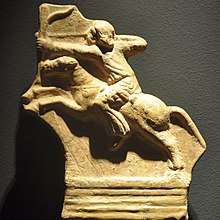Parthian army
The Parthian army was the army of the Parthian Empire (247 BC – 224 AD). Having no standing army, the Arsacid king mainly relied on his vassal kings, regional and tribal lords, and garrison commanders.[1] Mercenaries were also sometimes used in the army; however, this was only when the forces of the king were found lacking, or when a vassal refused to cooperate.[2] The leader of the army was the king, his son, or a spahbed (military commander) selected from one of the great houses.[1]

The army was mainly composed of Parthian nobles (azat) and their subjects whom they brought along.[1] The army did thus not endure for long, due to the nobles having to go back to their estates and crops.[1] The Parthian general wanted to finish the expedition as fast as possible and return home.[1] The king himself did not wish the campaign to fare for long, due to stress of a possible rebellion occurring in his realm, which frequently happened and was the biggest defect of the empire.[1]
The Parthian forces mainly consisted of two types of cavalry; the cataphracts, heavy cavalry with man and horse decked in mailed armor,[3] who formed the smaller part of the cavalry.[4] The second and main component of the cavalry were the mounted archers, light cavalry whose mobility and long-range warfare abilities made them a menacing enemy.[5] They used composite bows and were able to shoot at enemies while riding and facing away from them; this technique, known as the Parthian shot, was a highly effective tactic.[6] Parthians made less use of infantry, due to their less convenient role on the broad lowlands of Mesopotamia, Iran and Central Asia.[2] They were thus small in numbers and mainly used to guard forts.[7] The Parthians also made use of camel riders equipped with long lances, most likely recruited from the western frontier or nomadic allies.[8]
The successor of the Parthians, the Sasanians, incorporated the Parthian forces into their army.[9]
See also
References
- Shahbazi 1986, pp. 489–499.
- Dąbrowa 2010, p. 43.
- Brosius 2006, p. 120; Garthwaite 2005, p. 78
- Hauser 2006, p. 297.
- Dąbrowa 2010, p. 43; Hauser 2006, p. 299
- Brosius 2006, p. 120; Garthwaite 2005, p. 78; Kurz 1983, p. 561
- Dąbrowa 2010, p. 43; Shahbazi 1986, pp. 489–499
- Hauser 2006, p. 298.
- McDonough 2013, p. 603.
Sources
- Brosius, Maria (2006), The Persians: An Introduction, London & New York: Routledge, ISBN 978-0-415-32089-4
- Dąbrowa, Edward (2010). "The Arsacids and their State". XI: 21–52. Cite journal requires
|journal=(help)CS1 maint: ref=harv (link) - Garthwaite, Gene Ralph (2005), The Persians, Oxford & Carlton: Blackwell Publishing, Ltd., ISBN 978-1-55786-860-2
- Hauser, Stefan (2006). "Was there no paid standing army? A fresh look on military and political institutions in the Arsacid Empire". In Mode, Markus; Tubach, Jürgen (eds.). Arms and Armour as Indicators of Cultural Transfer: The Steppes and the Ancient World from Hellenistic Times to the Early Middle Ages. Reichert. pp. 295–319. ISBN 978-8779344433.CS1 maint: ref=harv (link)
- Kurz, Otto (1983). "Cultural Relations Between Parthia and Rome". In Yarshater, Ehsan (ed.). The Cambridge History of Iran, Volume 3(1): The Seleucid, Parthian and Sasanian Periods. Cambridge: Cambridge University Press. pp. 559–567. ISBN 0-521-20092-X..
- McDonough, Scott (2013). "Military and Society in Sasanian Iran". In Campbell, Brian; Tritle, Lawrence A. (eds.). The Oxford Handbook of Warfare in the Classical World. Oxford University Press. pp. 1–783. ISBN 9780195304657.CS1 maint: ref=harv (link)
- Shahbazi, A. Shapur (1986). "Army i. Pre-Islamic Iran". Encyclopaedia Iranica, Vol. II, Fasc. 5. pp. 489–499.CS1 maint: ref=harv (link)